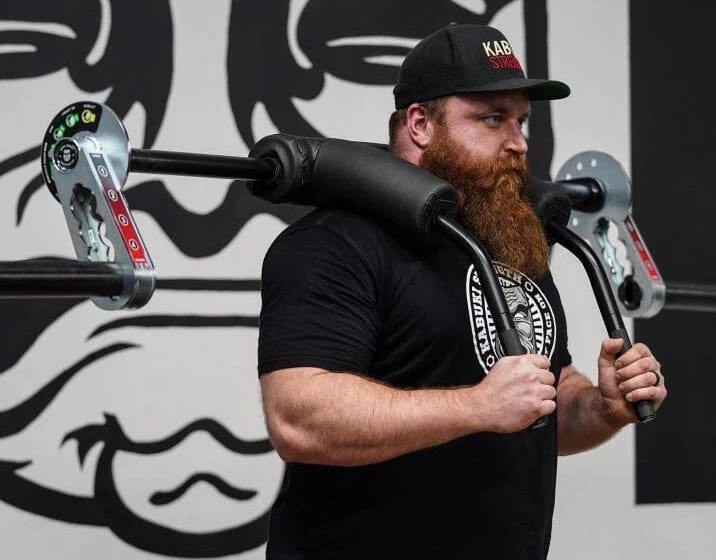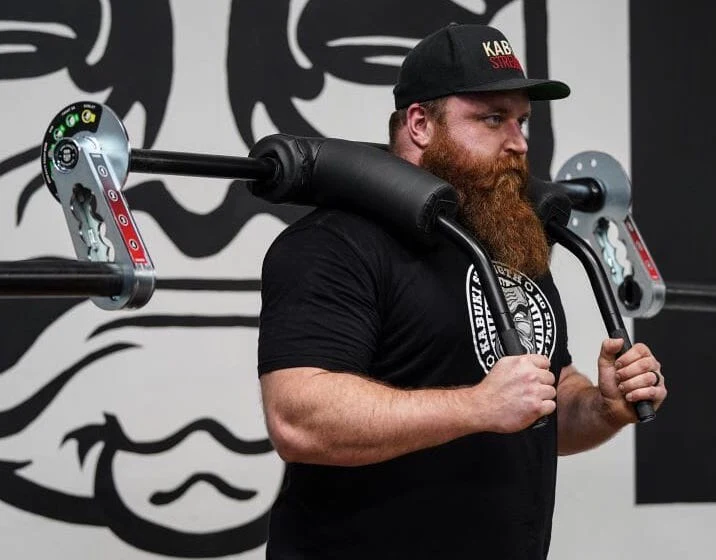The Kabuki Transformer Bar is a safety squat bar that uses adjustable loading positions to change how the lift feels during use. It is a must-have due to its adaptability, core-bracing facilitation of the handles, and the variation in exercise selection it offers. It has held up well in our personal training studio, and we have found many uses that help cater to our clients’ individual needs and programming.
Clients who experience limitations with traditional barbells or want more training variety will love this piece of equipment. The following review will explain how the Kabuki Transformer Bar works regarding core bracing and adaptability, its vast array of exercise varieties, and a few challenges to be aware of when using this bar.
Load Positioning Options Galore
The twenty-four unique combinations each have their specific loading position of the external weight. Loading position directly affects kinematics, kinetics, and muscle activation; therefore, it is essential to consider loading position when programming exercises for specific client needs. Clients with mobility restrictions can now have more training options due to the bar’s customization.
The arch-shaped camber angle adjustment allows the user to change the angle of the load relative to the user’s back, creating options for more familiar movements than a regular safety bar can provide. “The spring-pin mechanism allows for six positions with 30 degrees of variance between them.” (Kabuki.com) These fixed positions replicate common lower body movement patterns (all conveniently labeled on the adjustment face) from a goblet squat to a good morning.
The different positions create different moment arms, challenging different muscle groups, based on resistance placement.
“The second adjustment mechanism modifies the position of the weight sleeve, or distance between the center of mass of the weight and the bar on the lifter’s back.” . This means that the further the load is positioned from the body, the more torque is placed on the working muscles to overcome. Here the user has four different options, ranging from closer to the body (or backward-positioned) and gets farther away (forward-positioned).
While doing lower body exercises with a load supported by the torso, a more forward-positioned load will typically garner the following effects:
- Higher upright torso angle and higher ankle dorsiflexion
- Higher knee joint net moment
- Higher quadriceps activation and lower back extensor activation
While doing lower body exercises with a load supported by the torso, a more backward-positioned load will typically garner the following effects:
- Lower upright torso angle and lower ankle dorsiflexion
- Lower knee joint moment and higher hip joint net moment
- Lower quadriceps activation
- Higher glute and back extensor activation
With its two load position adjustments, the Kabuki Strength Transformer Bar allows highly-tailored exercises to be programmed to meet clients’ needs. Personal trainers can more precisely set the adjustments to target a certain joint or muscle group and remove force on another joint or muscle group.
More Variety Than Your Average Bar
Sometimes barbell exercises can become redundant and boring. With the Kabuki Transformer Bar, there are countless more options to implement into your training program. It’s no surprise that the six spring-pin positions offer an already extensive variety of exercise options:
- Hip Hinge – Ideal for good mornings and teaching hinge patterning
- Back Squat – Low Bar
- Back Squat – High Bar
- SSB – For use like a traditional safety squat bar
- Front Squat – Load counterbalancing similar to a front squat
- Goblet Squat – Similar to a kettlebell goblet squat
These only serve as the beginning of exercise variety. The Kabuki Transformer Bar can be used for many lower body exercises, with even some creative options for training the upper body. With the Transformer Bar set, here are some other exercise variations that are not shown on the above list:
- Lunge patterns
- Bulgarian Split Squats
- Single leg RDLs (use hip hinge setting)
- Offset stance good mornings (use hip hinge setting)
- Step-ups
- Side squats and split squats
- Yolk carry or other similar loaded carry
Core Bracing Facilitation of the Kabuki Strength Transformer Bar Handles
The Transformer Bar’s handles are convenient to hold and help brace the core by contracting the lats, chest, and surrounding shoulder musculature. Bracing the core is not limited to squeezing the abdominals but involves squeezing several other muscle groups, such as the lats and pecs.
While using the handles, actively pull them towards the body and think about squeezing them together. This action co-contracts the lats and pecs, contributing to overall core stability during exercise. This co-contraction is especially helpful when teaching clients who typically struggle with core bracing during lower-body exercises.

credit: kabukistrength.com/cdn/shop/files/BlackTbar2_2d2afdd6-ed92-48c3-9750-f14879673324_2048x.jpg?v=1691774576″>
What are the Cons? Minor Challenges Explored
We don’t regret purchasing the Kabuki Transformer bar at our personal training studio. However, we have learned some techniques to reduce any potential challenges.
One challenge with our bar is that the threads that secure the handle extensions can become loose and get stuck inside the end of the handle of the bar. This can easily be fixed using some Locktite to secure the thread in the removable handle extensions.
Adjusting the spring pin to select a different loading position at a certain weight takes a bit of work. We usually remove all weight to a plate on each side to adjust the pin easily.
Similarly, the barbell sleeves need to have the weight removed before adjusting. This delay can be avoided by sticking with a barbell sleeve position. However, it only takes a minute to remove the weight, so it isn’t a big deal to do so.
If the rack is wide, the lifter must be careful when reracking the Transformer Bar. Racking the bar off-center can result in the spring pin house hitting the rack. There is a very sturdy steel house welded around the spring pin mechanism, but repeated force over time could compromise the weld.
Is the Kabuki Transformer Worth Buying?
The Kabuki Transformer Bar is the best safety squat bar available. It is worth its price due to its comfort, strong manufacturing, and wide applicability to any training program. It has helped countless clients in our studio learn how to squat due to its high-density foam pad, ergonomic handles, and customization. If your studio needs a safety squat bar, this is it!
Brandon Hyatt, MS, CSCS, NFPT-CPT, NASM-CES, BRM, PPSC is an experienced leader, educator, and personal trainer with over 7 years of success in building high-performing fitness teams, facilities, and clients. He aspires to become a kinesiology professor while continuing to grow as a professional fitness writer and inspiring speaker, sharing his expertise and passion. He has a master's degree in kinesiology from Point Loma Nazarene University. His mission is to impact countless people by empowering and leading them in their fitness journey.


